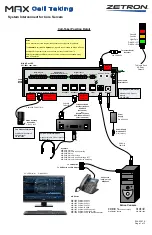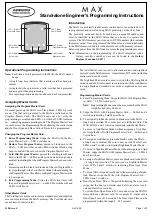
How to activate the second program?
You have to remove the jumper of the contact L2X from the conn and connect it with the contact -M-. Please see picture 21 below.
After turning on the microprocessor checks, which program he shall start. The second program will be used, because the contact L2X lies on minus now.
Any button can be connected to the switch with a twisted cable. So, the current position of the Servo stays and it will change only, if the button is pressed (picture 22).
If the controller is used in a difficult environment (“trouble-contaminated”) and if the cable is very long, then the disorders can be short-circuited with a further not inclusive ceramic
100 nF / 50 v capacitor at the entry. This should only be necessary in exceptional cases.
What should you avoid by using this Servo with Control?
It’s important to ensure as far as possible that the Servo with Control will be switched off in the state it has been switched on. If you don’t take care on this, during switching on the
Servo will be move to the starting position very quickly. The Servo doesn’t mind, but perhaps the mounted model. It’s not very easy to avoid this, because during turning on, the micro-
processor doesn’t know in which position the Servo is placed.
Absolutely to avoid:
If you have connected a button, then this button is supplied with a power of 5 volts from the controller.
In no case it’s allowed to connect the direct current or the alternating current voltage of the model railway transformer on the button contacts.
By using a control panel it’s very
important to check, that no 16-18 volts will be sent to the entry contacts of the controller.
How to interconnect the other E-Kits with the Servo with Control?
One or more E-Kits Servo with Controls can be connected e.g. with the “Twilight Switch” (purchase order number 60271). During dusk on the model system some attractions will be
switched on. For this a changeover the relay of the twilight switch will be switched on and off on the service pipe with the Twilight Switch. E.g. for the nocturnal railway works or for
the nocturnal loading and unloading. The second relay contact can be used for the construction site lighting.
Also the E-Kit “Light Barrier” (purchase order number 60271) can be interconnected with the Servo with Control. For this, a contact point of the relay will be used again. Instead of the
connected key button or the control panel the relay of the Light Barrier takes the switching function. If e.g. a truck reaches the position of the Light Barrier, an automatic loading can be
started by the Servo with Control. For this, shown in the following, e.g. the truck has to be set in a way, that a possible payload can fall directly into the truck.
Where I can show my own E-Kits installations?
www.mymocom.com is a platform for all model railway enthusiasts. There you can share your own ideas about the setting of the Servo with Control with others.
How does the program (software) of the microprocessor exactly work?
For everybody who wants to know exactly how the Servo is controlled: For moving the Servo, a so called pulse-width modulated signal will be sent from the microprocessor. Approxima-
tely every 20 msec an impulse of 1 to 2 msec is sent.
Is the pulse for example about 1 msec, the power is on Servo is on the one side. At 1.5 msec the Servo is in middle position and at 2 msec the Servo is in a different position.
The Microprocessor sends this to the Servo:
How does the controller (hardware) work exactly?
The escapement consists of:
• Microprocessor
• Power supply
• Entries and outlets
The microprocessor operates the stored program (software) line by line and so it can check the entries and regulate the outlets (Servo).
The central element is the microprocessor. The detector, the capacitors and the voltage regulator arrange a reliable power supply of the microprocessor.
The small components with the signature are resistors, which are soldered on the plate for the single entries and outlets of the microprocessor. To control a relay by the microprocessor,
there is a transistor on the board.
That’s the connection diagram of the control board:
What are the features of this microprocessor?
Every microprocessor has to be supplied with a pulse for implementing the program. For this, a lot of computers use an extern oscillating crystal. But this small micro computer has
installed a small intern pulse generator. Everything that is needed for a solution of the simple control task are implemented in only one computer chip. You only need to know 33 com-
mands to code a microprocessor.
Where I can find further information?
The manufacturer of the chip is a good resource to learn more about the microprocessor which is used here. On the website
www.microchip.com
you will find quickly something by
searching the used microprocessor. Enter “PIC10F200” in the search box “Search Data Sheets”. The data sheet of the microprocessor comprises approximately 100 pages. Here the
small microprocessor is described in detail.
NOCH GmbH & Co. KG
Lindauer Straße 49
D-88239 Wangen im Allgäu
Tel.: +49 - 75 22 - 97 80-0
Fax: +49 - 75 22 - 97 80-80
E-Mail: [email protected]
www.noch.de und www.noch.com
Modellbauartikel, kein Spielzeug!
Model building item, not a toy! Not suitable for children under 14 years!
Article de modélisme. Ceci n’est pas un jouet.
Articolo di modellismo, non è un giocattolo!
Artículo para modelismo ¡No es un juguete!
Artigo para modelismo. Este artigo não é um brinquedo!
Výrobek ur`´cený pro modelá`´re, nejedná se o hra`´cku!
Modelbouwartikel, geen speelgoed!
Made in China.


























